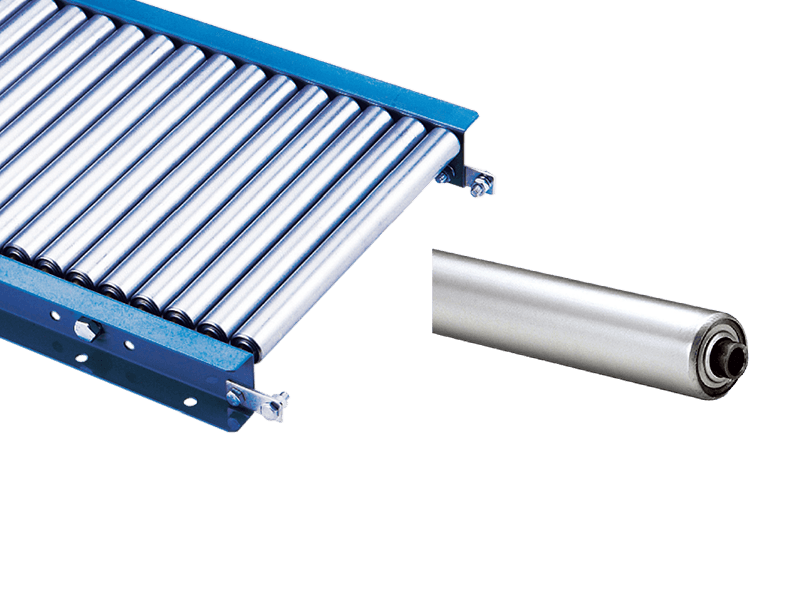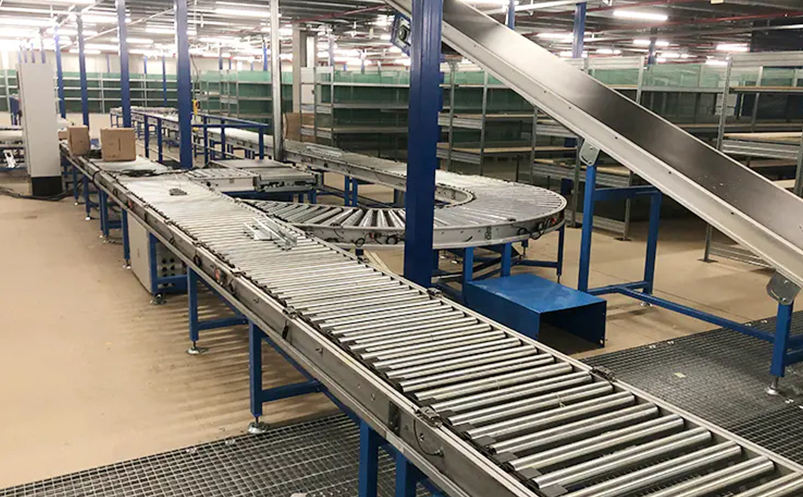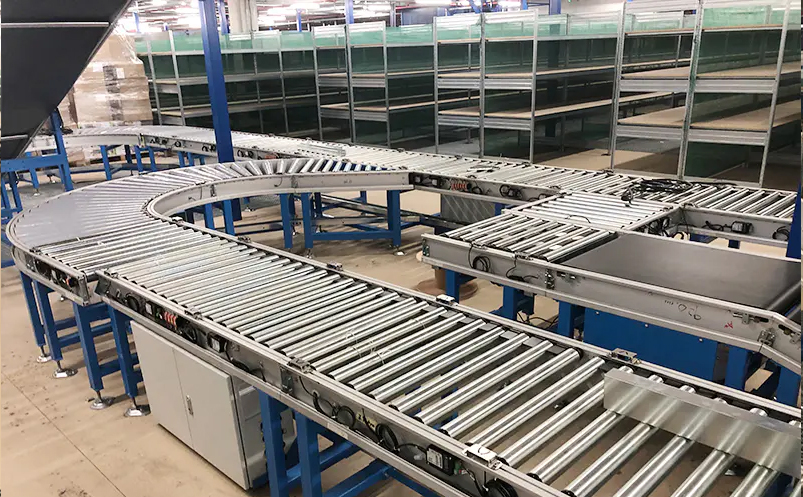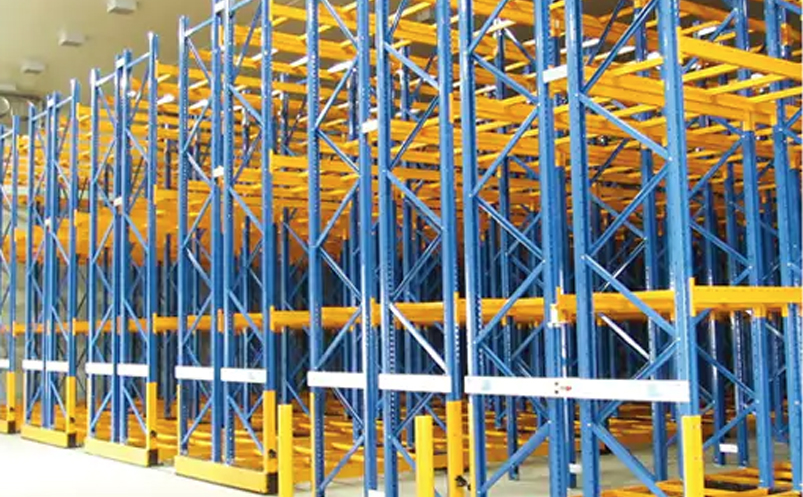1. Overview of roller conveyor
Roller conveyor is a continuous conveying equipment widely used in industrial production, logistics warehousing and packaging industries. It consists of a series of parallel rollers, and the conveying of goods is achieved through the rotation of the rollers. Compared with other conveying equipment, roller conveyor has the advantages of simple structure, easy maintenance and strong adaptability. It is an indispensable key equipment in modern automated production lines and logistics systems.
2. Main types of roller conveyors
1. Classification by drive mode
|
Type |
Working principle |
Advantages |
Disadvantages |
Applicable scenarios |
|
Gravity roller conveyor |
Transportation is achieved by relying on the weight of the object and the inclination angle of the conveyor line |
No power required, energy-saving and environmentally friendly, simple maintenance |
The conveying speed is uncontrollable and requires a certain height difference |
End of packaging line, warehousing and sorting, light goods transportation |
|
Powered roller conveyor |
The motor drives the roller to rotate and transport the object |
Controllable conveying speed, horizontal or slope conveying |
High energy consumption and complex maintenance |
Automated production line, heavy goods transportation, precise control occasions |
|
Electric roller conveyor |
Each roller has an independent built-in motor drive |
High control accuracy, segmented control |
High cost and high maintenance technology requirements |
High-precision automated line, intelligent logistics system |
2. Classification by roller material
- Steel roller: strong load-bearing capacity, suitable for conveying heavy goods
- Stainless steel drum:Corrosion-resistant, suitable for industries with high hygiene requirements such as food and medicine
- Plastic roller:Lightweight and low noise, suitable for light items and quiet environments
- Rubber coated roller:The surface is covered with rubber or polyurethane to increase friction and cushioning performance
3. Classification by structural form
- Linear roller conveyor:The most basic form of conveying, used for straight-line conveying
- Curved roller conveyor:Used to change the conveying direction, usually at standard angles such as 30°, 45°, 90°, etc.
- Telescopic roller conveyor:The length is adjustable, suitable for loading and unloading and other occasions where flexible length is required
- Lifting roller conveyor:Height adjustable, used for connecting production lines of different heights
3. Core parameters and selection guide of roller conveyor
1. Key technical parameters
|
Parameter name |
Description |
Selection points |
|
Roller diameter |
Usually 25mm-150mm |
The smaller the item, the smaller the roller diameter should be; heavy items require large-diameter rollers |
|
Roller spacing |
Center distance between adjacent rollers |
Generally 1/3-1/4 of the item length, ensuring that at least 3 rollers support the item at the same time |
|
Conveying speed |
Important parameters of powered roller conveyor |
Determined according to production process requirements, generally 5-30m/min |
|
Carrying capacity |
Maximum load per unit length (kg/m) |
The peak load should be considered, leaving a 20%-30% safety margin |
|
Conveying angle |
Tilt angle during gravity conveying |
Usually 2°-7°, depending on the weight of the item and the bottom material |
2. Selection Steps Guide
- Clarify the characteristics of the transported items:Including size, weight, bottom material, shape, etc.
- Determine conveying requirements:Conveying volume, speed, direction change, special process requirements
- Select conveyor type:Determine gravity type or dynamic type and specific structural form based on the results of the first two steps
- Calculate key parameters:Roller diameter, spacing, motor power, etc.
- Consider environmental factors such as temperature, humidity, corrosion, cleanliness, etc. to select suitable materials and protection levels. Control systems such as PLC, inverters, sensors, etc. should be selected according to the degree of automation and production rhythm requirements.
3. Common selection errors and how to avoid them
- Mistake 1: Underestimating Peak Loads- The heaviest items in production and possible accumulation should be considered
- Mistake 2: Ignoring the properties of the bottom surface of the object- Soft or uneven surfaces may require special roller designs
- Mistake 3: Ignoring maintenance space- Sufficient space should be reserved for maintenance and repair
- Mistake 4: Not considering future expansion- The design should take into account possible capacity increases and process changes
4. Industry application cases of roller conveyors
1. E-commerce logistics center application
A large e-commerce logistics center uses a composite conveying system consisting of a powered roller conveyor and a gravity roller conveyor to achieve automated conveying of packages from sorting to loading. System features:
- Modular design allows for flexible expansion according to business volume
- Use rubber-coated rollers at key locations to reduce wrapping damage
- Equipped with intelligent diversion device to achieve automatic sorting
- The system processing capacity reaches 8,000 pieces/hour, and labor costs are reduced by 40%.
2. Application in automobile manufacturing industry
A certain automobile parts production line uses a heavy-duty powered roller conveyor to transport engine components. Technical parameters:
- Roller diameter: 89mm, surface covered with polyurethane
- Conveying speed: adjustable, working speed 12m/min
- Maximum load: single piece 800kg, line load 2000kg/m
- Equipped with precise positioning device, positioning accuracy ±2mm
3. Application in food processing industry
A food factory uses stainless steel roller conveyors to form a packaging production line to meet hygiene requirements:
- Made of stainless steel, in compliance with FDA standards
- The drum has no dead angle design, which is easy to clean
- Equipped with food grade lubricant
- Anti-water accumulation design to prevent bacteria growth

5. Installation and maintenance of roller conveyor
1. Installation precautions
- Basic preparation:Ensure that the installation ground is flat and has sufficient bearing capacity
- Horizontal adjustment:Use a level to adjust the gravity conveyor to ensure the correct inclination angle
- Docking accuracy:When connecting multiple conveyors, ensure that the height and center line are consistent
- Electrical Safety:Powered conveyors should be properly grounded and overload protected
2. Daily maintenance points
|
Maintenance items |
Cycle |
Operation contents |
Precautions |
|
Drum cleaning |
Daily/class |
Remove surface debris and dust |
Avoid using corrosive cleaning agents |
|
Bearing lubrication |
Monthly/500 hours |
Add appropriate amount of grease |
Use designated lubricants |
|
Chain inspection |
Quarterly |
Check tightness and wear |
Adjust or replace in time |
|
Motor inspection |
Half-yearly |
Check insulation, carbon brushes, and bearings |
Have professional electricians perform the operation |
|
Overall overhaul |
Annually |
Check the status of all components |
Keep maintenance records |
3. Common troubleshooting
- The drum does not rotate:Check whether there is any foreign matter stuck, whether the bearing is damaged, and whether the lubrication is sufficient.
- Conveying deviation:Adjust the horizontality of the frame and check the parallelism of the rollers.
- Abnormal noise:Check bearing wear, chain tightness, and roller deformation
- Motor overheating:Check whether the load is too large, the voltage is normal, and the heat dissipation is good.
6. Development trend of roller conveyor
1. Intelligent development
Modern roller conveyors are developing towards intelligence, mainly manifested in:
- Equipped with IoT sensors to monitor operating status in real time
- Integrate with MES system to realize automatic collection of production data
- Adaptive control technology automatically adjusts speed according to load
- Predictive maintenance to detect potential failures in advance
2. Energy saving and environmental protection
- Application of high-efficiency motors and frequency conversion technology reduces energy consumption
- Rollers made from renewable materials
- Low noise design improves working environment
- Long life design reduces waste generation
3. Modularity and flexibility
- Standardized interface design for quick assembly and modification
- Reconfigurable conveying system to adapt to multi-variety production
- Hybrid conveying technology, combining different conveying methods such as rollers, belts, chains, etc.
7. FAQ
Q1: How to calculate the motor power required for the roller conveyor?
The following factors should be considered when calculating motor power:
- Total weight of conveyed items (including possible accumulation)
- Conveying speed
- Friction coefficient (roller and items, roller and bearings, etc.)
- Conveyor tilt angle (if any)
- Transmission efficiency
Basic formula: P=(μ·m·g·v)/η + (m·g·sinθ·v)/η
Where: P-power (W), μ-friction coefficient, m-mass (kg), g-gravitational acceleration, v-speed (m/s), η-transmission efficiency, θ-tilt angle
It is recommended to consult a professional engineer for detailed calculations and leave a 20%-30% power margin.
Q2: Can roller conveyors transport small items?
Yes, but special design is required:
- Reduce the roller spacing (usually 1/4-1/3 of the length of the item)
- Use a small diameter roller (such as 25mm-38mm)
- Consider adding a guide device to prevent the item from falling
- For very small items (such as <100mm), it may be necessary to use a belt conveyor
Q3: How to choose between roller conveyor and belt conveyor?
|
Comparison items |
Roller conveyor |
Belt conveyor |
|
Applicable items |
Goods with flat bottom and good rigidity |
Various shapes, including soft bags and small pieces |
|
Carrying capacity |
High, suitable for heavy goods |
Medium and heavy duty require special design |
|
Transportation angle |
Gravity type needs to be tilted, power type can be horizontal |
Can achieve large angles and even vertical conveying |
|
Cleaning and maintenance |
Relatively easy |
Belt cleaning is more complicated |
|
Cost |
Medium |
Simple applications are lower, complex applications are higher |
Q4: What is the typical service life of a roller conveyor??
Under normal use and maintenance:
- Gravity roller conveyor: 8-12 years
- Ordinary powered roller conveyor: 6-10 years
- High-intensity use: 3-5 years
- Key components (such as motors, bearings) may need to be replaced mid-life
The main factors affecting lifespan include: load conditions, operating environment, maintenance frequency, operating specifications, etc.
8. Conclusion
As an indispensable conveying equipment in modern industrial production, the correct selection and use of roller conveyors are crucial to improving production efficiency and reducing operating costs. We hope that through this guide, you can fully understand the various characteristics and application points of roller conveyors, and provide valuable reference for your purchasing decisions and production optimization.







